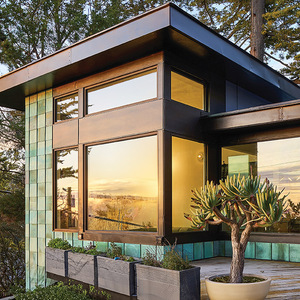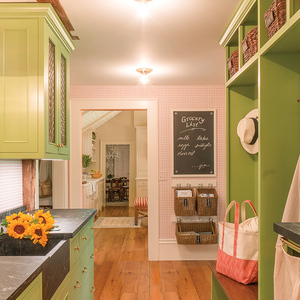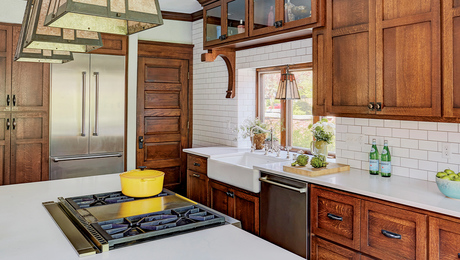A Cabinetmaker’s Kitchen
A new kitchen combines exemplary woodworking and a practical plan.

Synopsis: Andrew Jacobson had been building cabinets and furniture for clients all over the world for years when he decided to tackle a project closer to home: his own kitchen. With assistance from his wife, an authority on the cultivation of Asian medicinal plants, Jacobson was guided by a Japanese aesthetic, which emphasizes natural materials—especially wood. The predominant cabinet wood he used was quartersawn beeswing sapele, but he also used Douglas-fir trim, red-elm for a linen cabinet, jatoba flooring, and a walnut slab for a peninsula. Other features include a marble-slab backsplash behind the stovetop, a bump-out at the sink, a sliding gate to keep the dog out of the kitchen, and a rollout shelf that can be used as a landing pad for hot pots.
For 25 years, Andrew Jacobson has been building museum-quality cabinets and furniture for clients all over the world. From baronial chairs with woven tassels to art-deco armoires with ebony inlay, Jacobson’s company, Petaluma, Calif.- based Design in Wood Inc., has built them all. Jacobson crafts whatever his clients can imagine, no matter how complicated. Turned loose to build his own kitchen, Jacobson looked across the Pacific to the understated elegance and apparent simplicity of Japanese design. It’s a timeless aesthetic that puts the emphasis on natural materials — especially wood.
Other than “Aha, I can build a kitchen that demonstrates what our shop can do,” there really wasn’t a pivotal design goal that unlocked the final plan. Instead, Jacobson and his wife, Peg Schafer, had the luxury of time to work on getting it right. Schafer, an authority on the cultivation of Asian medicinal plants, further strengthened the kitchen’s Far East connection.
The predominant cabinet wood is quartersawn beeswing sapele, with its ribbony pinstripes arranged vertically, like delicate curtains. The Douglas-fir trim, red-elm linen cabinet, jatoba flooring, and walnut-slab countertop were, like the sapele, all acquired from either FSC-certified forests or salvage resources.
The abundant wood, reserved in color and figure, is stopped short of being overwhelming by the other materials in the room. Hand-tooled plaster walls and ceilings bring slight imperfections to the mix. The curvy peninsula countertop, the stainless steel range hood, and the walnut-slab table soften the rigid grid of the frame-and-panel cabinets. It all adds up to a soothing space to begin and end each day.
For more photos, drawings, and details, click the View PDF button below:

























